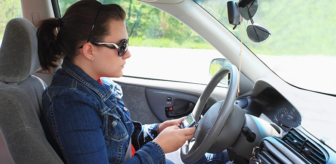Teen drivers put everyone on the road at risk, especially when they bring teen passengers along for the ride, updated research from the AAA Foundation for Traffic Safety reports.
— an announcement from AAA Northeast
In fact, when a teen drives their peers, the fatality rate for all people involved in a crash — the driver, passengers, occupants of other vehicles, and other roadway users like pedestrians and cyclists increases by 51 percent because teens are inexperienced drivers, the report said.
“Teens simply lack experience behind the wheel,” said Fran Mayko, AAA Northeast spokeswoman. “This increases the odds of a deadly outcome, not just for the driver, but for the passengers and others on roads.

Photo from the American Automobile Association website
Distracted driving is one factor in the high crash rates for teenage drivers.
The newest research is part of a AAA Foundation study, “Everyone’s at Risk”, updated to mark National Teen Driver Safety Week (Oct. 21 to 27) next week.
The study also found fatality rates of teen-driver related crashes increased when factors like speeding or night driving were introduced, she added.
One Million-Plus Teen-Driving Crashes, 3,200 Deaths in 2016
According to the updated study, teen drivers were involved in more than 1 million police-reported crashes nationally, resulting in more than 3,200 deaths in 2016 and when teens carried teen passengers, fatality rates jumped by:
- 56% for occupants of other vehicles;
- 45% for the teen driver; and
- 17% for pedestrians and cyclists
Teen-Driving Crashes, Injuries and Deaths in Connecticut
A look at statistics closer to home – in Connecticut – also confirms a teen driver/teen passenger combo is at greater risk.
In 2017 in Connecticut, there were 810 crashes involving a teen driver who carried at least one teen passenger, according to data obtained through UCONN’s Crash Data Repository. Of this overall number:
- 22 percent resulted in crashes with injuries involving only a teen driver
- 33 percent resulted in crashes with injuries involving a teen driver carrying one passenger; and
- 42 percent resulted in crashes with injuries involving a teen driver carrying more than two passengers.
In 2016 in Connecticut, there were 18 fatalities in crashes involving teen drivers — six were drivers, six were passengers, four were occupants of other vehicles and two were pedestrians or cyclists, according to federal government data published in the report.
What Parents Can Do
The AAA study pointed out, however, when older passengers (35 years or older) such as parents or older relatives accompanied a teen driver, those overall national fatality crash rates dropped 8%.
“Strong coaching and diversity in practice driving sessions are key when teens have learner’s permits,” said Mayko. “Once teens have their licenses, consistent parental involvement is essential.”
To help parents coach teen drivers, AAA offers various resources on TeenDriving.AAA.com.
In addition, AAA recommends teens:
- Log at least 100 hours of supervised practice driving with a parent or guardian before driving solo;
- Practice driving in low-risk situations at first and gradually move to situations that are more complex such as highways, night driving, driving in the rain, and on challenging roadways;
- Use slightly different routes each practice session; and
- Practice driving based on three factors: visibility, on-road traffic and different road conditions.
AAA recommends parents discuss the higher risks teens face with additional passengers and become actively involved in the learn-to-drive process involving their inexperienced teen.
Connecticut parents also should familiarize themselves and comply with the state’s Graduated Driver’s License laws on the www.ct.gov/dmv website. CT’s GDL restrict new teen drivers from carrying any passengers other than an adult for the first six months they hold a license. During the second six month, the new driver may only drive with immediate family members.
Up until their 18th birthday, new teen drivers must comply with an 11 p.m.-to-5 a.m. curfew (there are limited exemptions); require all their passengers to wear seat belts; and refrain from using mobile electronic devices including hands-free devices while driving.
About the study
Data used in Everyone’s at Risk 2018 came from the 2016 National Highway Traffic Safety Administration (NHTSA) Fatality Analysis Reporting System (FARS) and the Crash Report Sampling Survey System (CRSS).
The FARS database includes all motor vehicle crashes on public roadways that resulted in a fatality within 30 days of crash. The CRSS database is a nationally representative probability sample of all police-reported crashed in the United States.
AAA Northeast is a not-for-profit auto club with 67 offices in Connecticut, Rhode Island, Massachusetts, New Jersey, New Hampshire and New York, providing more than 5.7 million AAA members with travel, insurance, financial and auto-related services.
In Connecticut, we serve a half-million members in Fairfield, New Haven, and Litchfield Counties.


